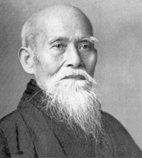|
Morihei Ueshiba
The Founder of Aikido, was born on December 14th
1883 and later known as "O Sensei". Weak and unhealthy as a child, and
trained in a variety of martial arts to gain health and strength.
Martial Arts Experiences
Ueshiba's first master was Tozawa Tokusaburo, who
taught him jujitsu from the age of 13. By the age of 20 Ueshiba was already
a recognised expert in the use of the sword and the spear.
Spiritual and Religious Influences
He trained in Daito Ryu Aikijitsu under Sokaku Takeda
where much of Aikido originates. He was religious and followed Bishop Deguchi
and the Omotokyo sect, and he regarded Aikido as a way of achieving enlightenment.
During his life he had many students, most of
whom went on to form their own schools of Aikido. As he got older the spiritual
side of Aikido and his life became more important, so that those students
who left earlier taught a 'harder' style, such as Yoshinkan, while those
who left towards the end of his life teach a 'softer' style, such as Aikikai
whose head is Kisshomaru Ueshiba, the son of Morihei Ueshiba. |
